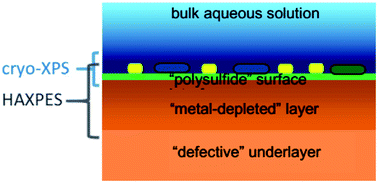Reaction surfaces and interfaces of metal sulfides: cryo-XPS meets HAXPES and DFT†
Abstract
We report here the application of the low-temperature X-ray photoelectron spectroscopy (cryo-XPS) of fast-frozen dispersions as a quasi in situ technique for a case study of metal sulfides reacted in acidic aqueous solutions under non-oxidizing and moderate oxidizing conditions. The sulfide surfaces are known to tend to be depleted in metals, producing essentially sulfur-enriched surfaces and extended underlayers on Fe- and Cu-bearing sulfides, which have previously been examined using depth-sensitive HAXPES and cryo-XPS. The current study is focused on zinc and lead sulfides (natural sphalerite and galena), for whom both the experiment and theoretical DFT simulations suggest a low stability of sulfur-excessive structures. Cryo-XPS revealed the complicated behavior of the minerals under non-oxidative etching conditions, in particular, a notable concentration of polysulfide for PbS in dilute perchloric acid and a very minor one in hydrochloric acid. Oxidative etching with Fe3+ cations produced polysulfide anions and then elemental sulfur, which both volatized in the ultra-high vacuum at room temperature; the species can, nonetheless, be distinguished by considering the binding energies, electrostatic charging and evaporation rates. The cryo-XPS also detected interfacial products, e.g., ferrous chloride. DFT found that S-excessive centers are unstable in the undersurface regions of both materials, but are less unfavorable for ZnS surfaces, in agreement with the experimental data. It was concluded that cryo-XPS allows us to greatly reduce distortions of the interface composition in comparison with conventional techniques.

- This article is part of the themed collection: Photoelectron spectroscopy and the future of surface analysis


 Please wait while we load your content...
Please wait while we load your content...